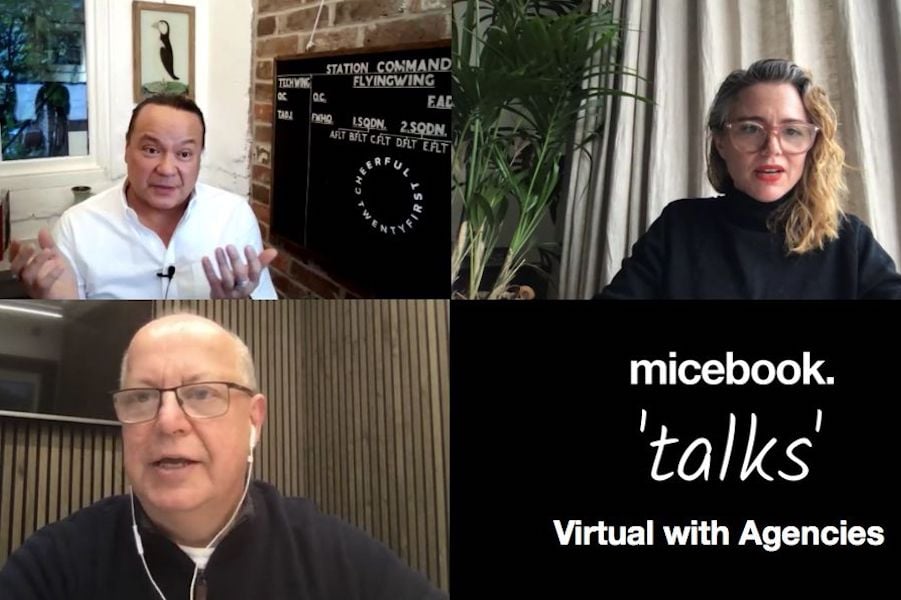From coaching speakers on how to present in the virtual world to getting clients to understand the importance of production values, our panel of agency experts from DRPG, OrangeDoor and Cheerful Twentyfirst shared some of their key challenges and learnings around hybrid and virtual events.
Our latest micebook talks session featured DRPG CEO Dale Parmenter, Cheerful Twentyfirst CEO Steve Quah and OrangeDoor managing director Dina Green, as part of our November focus on focus on hybrid and virtual events.
Here we share some of the key takeaways…
*Although all three agencies have offered virtual events solutions for many years, they have understandably seen a massive increase in demand for virtual events in 2020 – Cheerful Twentyfirst is delivering 50 events in November alone, while DRPG has delivered more than 450 virtual events to over a million viewers in 2020.
*The three leaders agreed that although nothing beats live events, virtual and hybrid are here to stay and they expect it to account for more than 50% of their business in 2021.
*Green said that the level of analytics and measurement you can get with virtual events is a positive. “Clients are really loving the fact you can get some very precise data and stats about specific individuals when you are doing virtual. You can produce real ROI that they didn’t have as precisely from live events. For example, how long attendees are staying in a room, how long they engage for and what they engage with. Marketing directors are enjoying this.”
*Quah added: “Where we are getting a lot of cut-through is on results and sales conversations. For example, where an event has gone from 300 to 2,000 people and they have got better results than the live event – we can’t hide that.”
*The panel discussed the fact it’s more difficult to engage audiences virtually and have a lasting impact. “We are human and being human means being with people and being able to feel that sense of togetherness. The more you can have an emotional impact on people, the more you will have a lasting impact on them,” said Green. “One of things we have found to be really effective with clients has been bringing that live and shared physical element into virtual events. If you can send a group of people the same thing that they open and share together, that seems to have more of an impact.”
*Parmenter said that many clients are keen to move to hybrid events to get the audience back in the room. “Some of the CEOs we work with loved doing the virtual event once, but once was enough. They are real showmen they love being on stage and are passionate about live communications. What these CEOs is not getting with a virtual event is any feedback there and then off the stage, they are not living and breathing that emotion. You can’t beat that emotional shared experience of being in the same room as other people.”
*In terms of the challenges faced, Quah said that some clients underestimated how much time you have to invest in creating a show online. “You still have the strategy and the content piece, but you also have the production values. It is more complicated to do a content piece to camera professionally and engagingly than it is in a live experience. It’s been an education process for clients and the budgets were ridiculous at the beginning, but they are more realistic now. To be fair to clients, it was quite hard for them to buy in the early days. Innocently they thought that was what they could get. Some of them have gone off and used a platform on their own and have come back after shocking experience and now they understand the need for production values and why they need an agency.”
*Parmenter agreed that producing content to camera is more challenging, particularly for speakers. “We have seen presenters walk into the studio in that live event mode in their head – they have their script and slides and they want a lectern and we have to try and help them understand they need to think of it more as a TV show than a conference,” he said. “You get some people who are very competent on a live stage but fall apart in the studio setting. In that situation, we try and change the format and do more of a sofa chat. One of the things we did earlier in the year when we were doing lots of sofa chats with people joining via Zoom or Teams, which worked really well, was to build sofas with screens in them so the presenter was actually talking to someone on the screen next to them.”
*As hybrid events become more complicated, with multiple hubs, multiple presenters and multiple audiences, the agencies agreed that these events could potentially end up costing clients more than it would to fly everyone to a single location for one live event.
*For hotels and venues planning to turn event spaces into studios to meet the growing demand for hybrid events, Parmenter advised to make sure the infrastructure and connectivity is up to the task. “You also need to think about things like fixing points, access, power requirements, lighting, whether the room is soundproof and if it needs to be draped to dampen the sound. There is a list of things you need to check to make sure it fits the criteria for a studio.”
*And finally the agencies agreed that there could be potential issues with staffing and resource when live events do come back, as many live event teams have been retrained on virtual. All three agencies are currently recruiting and said they may need to use freelance talent to support on both virtual and live projects.
You can watch the full session on our Voice Forum
Please see our Virtual Event Guide here.

